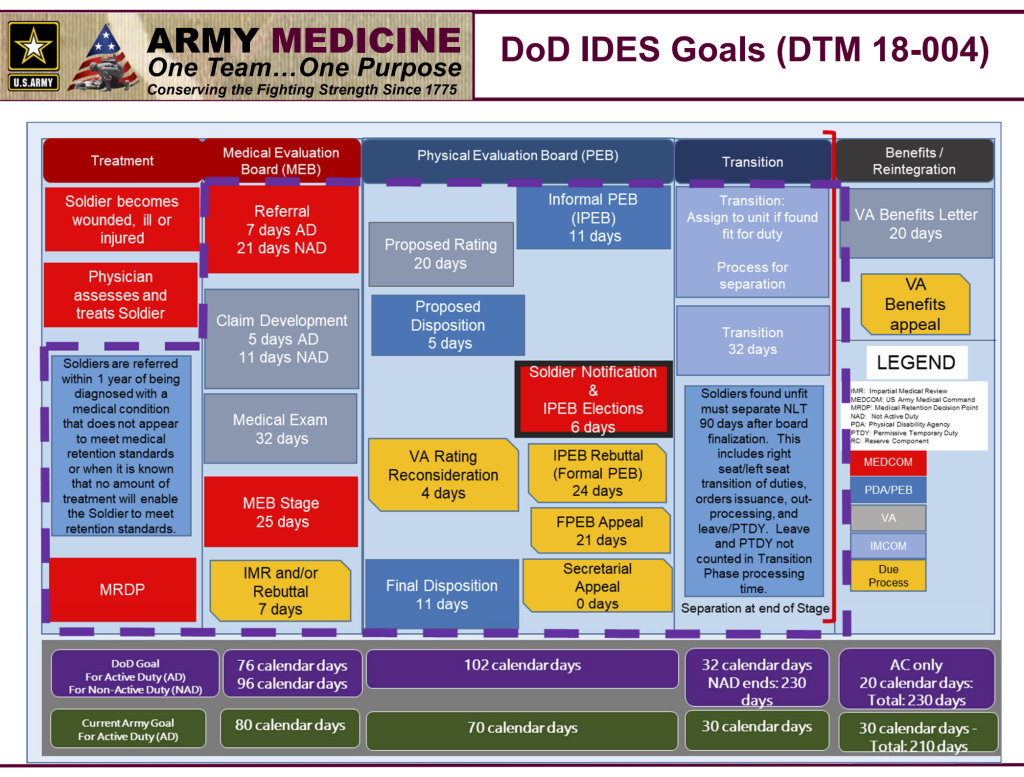- Contact Us Now: (615) 490-6020 Tap Here to Call Us
Legal Overview of the U.s. Department of Defense Integrated Disability Evaluation System

Service members that are in the process of determining if they are fit to return to duty or should be medically separated or discharged from the military due to their illnesses or injuries participate in the Integrated Disability Evaluation System (IDES). The military calls it integrated because this process is done in conjunction with the federal department of Veterans Affairs to also determine the servicemembers entitlement to VA disability at the same time as determining the servicemember’s entitlement (if any) to military disability for retirement purposes. More information regarding the IDES is located on the VA website here, and the health.mil website here.
The possible outcomes from IDES for the military are:
- Finding the Servicemember is fit for duty and is returned to duty. There is therefore no medical separation or retirement for the servicemeber. Presumably the servicemember will continue his military service until later separated or retired.
- The servicemember is found unfit and determined to be 10% or 20% disabled. In this event, the servicemember will be medically discharged but not retired. The servicemember is entitled to a one time severance payment, but not a medical retirement pension.
- The servicemember is found unfit and determined to be 30% or more disabled by the service. In this case the servicemember is medically retired and entitled to a military retirement pension for life. This pension should be effective immediately. The servicemember should also be entitled to other benefits of military retirees and free healthcare for the rest of her life.

Download the chart here to view in full-screen: IDES Slide to add to blog post
Using a hypothetical military servicemember as an example, the disability evaluation system is like this:
Hypothetical Navy Chief Petty Officer George Washington is in the active duty US Navy. He is assigned to duty on an Aircraft Carrier. While engaged in the course of his duties on the ship, Washington is carrying heavy equipment up a flight of stairs with other servicemembers. Unfortunately, Washington loses his balance near the top of the stairs and falls severely injuring his back and also injuring his left knee. Washington is treated on the ship after the injury occurred. Washington is transported to a hospital and has surgery on his back, yet he suffered a lumbosacral strain and bulging discs that cannot be completely repaired. Washington’s command referred him to the IDES system to determine if he is fit for duty or should be medically separated.
Washington’s IDES process begins with Washington receiving a briefing about the IDES system and he meets with his assigned Physical Evaluation Board Liaison Officer (PEBLO). The PEBLO provides more information that Washington may reference regarding the process. The Medical Evaluation Board (“MEB”) is the stage in the process where the military will determine what conditions if any fail to meet retention standards. Each service has their own regulation regarding retention standards. The MEB determined that Washington’s lumbosacral strain and bulging discs each fail to meet retention standards, but his left knee does not fail to meet retention standards. The MEB records their proceedings on DA form 3947. The MEB referred Washington to a Physical Evaluation Board (“PEB”). The PEB determined that Washington’s lumbosacral strain entitled him to 10% disability from the Navy. The VA determined this as 20% disability. Washington’s bulging discs entitled him to 10% disability from the Navy. The VA rated them as 20% disability. The PEB was not able to rate Washington’s left knee as that did not fail to meet retention standards. The VA gave Washington 10% disability for his left knee.
Under this hypothetical, Washington will be medically separated from the Navy, not medically retired. This is because his military disability percentage is calculated at 20% instead of the 50% calculation used by the VA. Washington will receive a severance payment but not full medical retirement.
How can a Private Attorney help in the IDES process?
A private attorney may assist a client at all stages of the IDES process from inception of the case through actions such as ensuring the client gathers and includes all relevant military medical documentation, requesting an Impartial Medical Review (“IMR”) with a memorandum specifying why an impartial medical review is required. A private attorney may also assist a client with submitting a written rebuttal to the MEB after the IMR. After the MEB process is complete, the case is transitioned to the Physical Evaluation Board (“PEB”) for further processing which will include a proposed rating. The servicemember will be notified of the PEB results. The servicemember may formally appeal the PEB decision through a IPEB rebuttal. Assuming the servicemeber is being medically separated or retired from the military, the servicemember will then start the separation process. After separation, the servicemember should receive the final rating from the VA with the final VA disability rating. The servicemember may appeal the final VA rating within one year.
Military servicemembers that have already been separated may also work with private attorneys in some cases. I have successfully represented clients before the Physical Disability Board of Review (“PDBR”), Board for corrections of Military Records, and Board for corrections of Naval Records.
Successful Military Medical Retirement Case Example
In one case I am particularly proud of, I successfully achieved a military medical separation for my client who was medically discharged from the U.S. Air Force in 2003 with 20% disability. We originally applied to the PDBR arguing that he should have been found 40% disabled when retired. We were upset that the application was not approved because we felt that it was strongly supported by documentary evidence. There are no rights to appeal from the PDBR so we revised the application slightly and sent it to the Air Force Board for Corrections of Military Records. We were pleasantly surprised that the AFBCMR agreed with our argument and awarded the client a full military medical retirement backdated to 2003. The client and I were both thrilled that he is now considered medically retired. The client is now awaiting six years of backpay military retirement benefits and future military medical retirement pension.
If you are a current or former military service member dealing with military medical retirement issues and could use a helping hand, call our office today to set up a consultation with one of our military law attorneys to explore your options. Let us help you navigate, litigation, and resolve your military medical retirement case.















